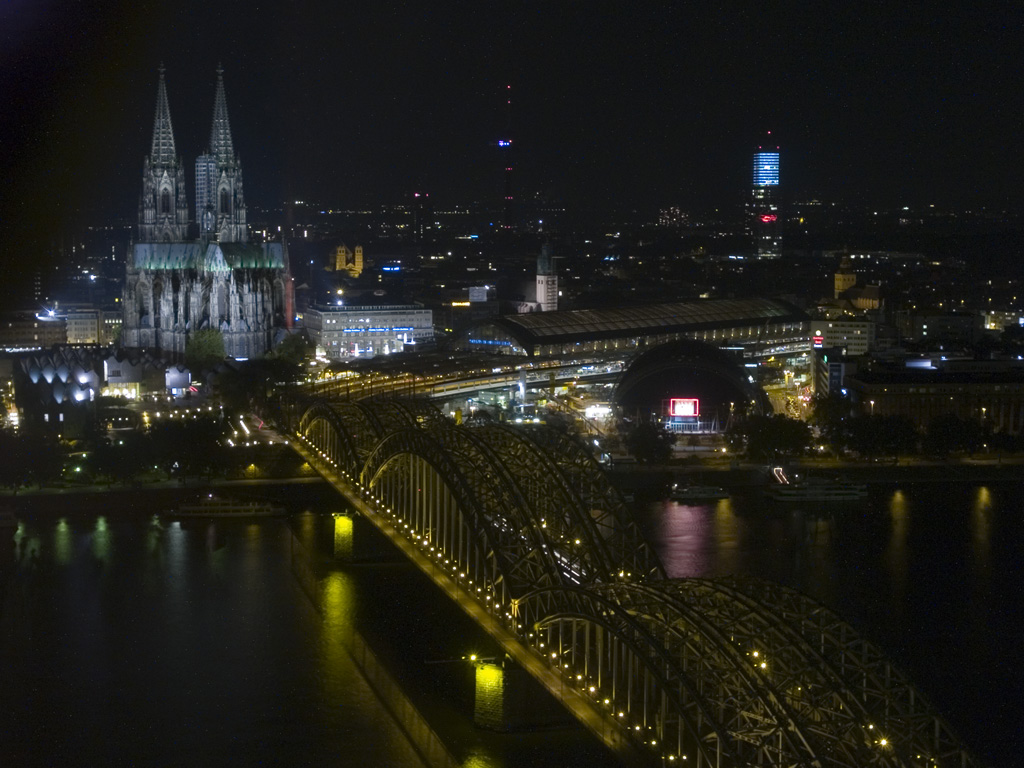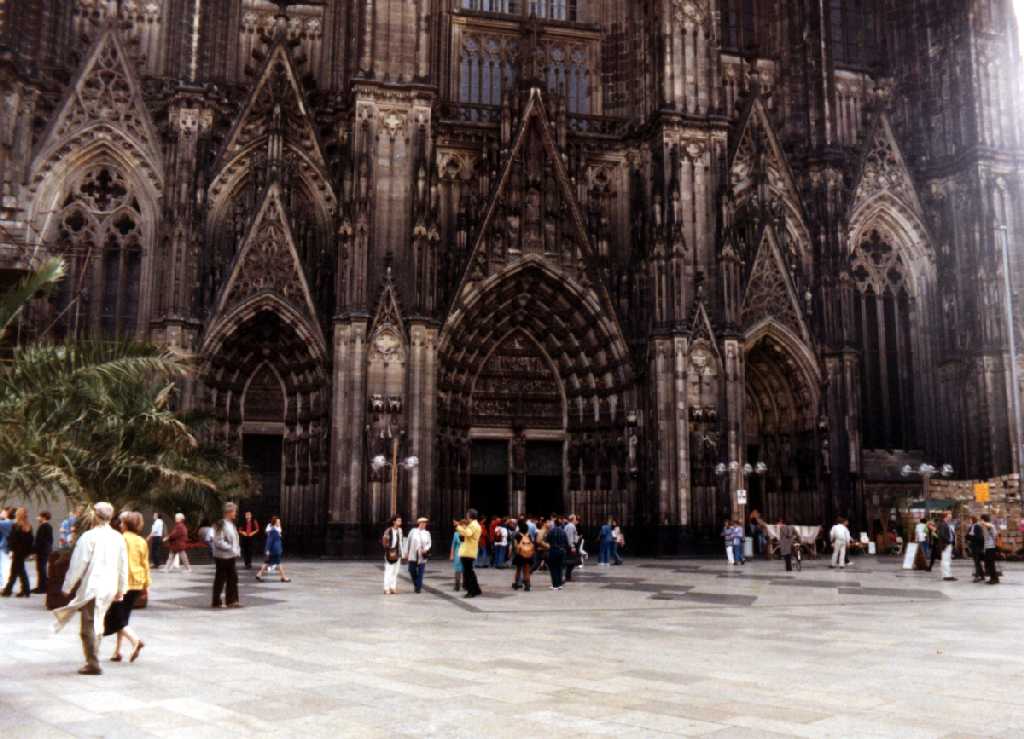

Cologne is Germany's fourth-largest city after Berlin, Hamburg and Munich, and is the largest city both in the German Federal State of North Rhine-Westphalia and within the Rhine-Ruhr Metropolitan Area, one of the major European metropolitan areas with more than ten million inhabitants. It is one of the oldest cities in Germany, having been founded by the Romans in the year 38 BC. Cologne was granted the status of a Roman "city" in the year 50 AD.

Cologne lies on the River Rhine. The city's famous Cologne Cathedral (Kölner Dom) is the seat of the Roman Catholic Archbishop of Cologne. The University of Cologne (Universität zu Köln) is one of Europe's oldest universities.
Cologne is a major cultural centre of the Rhineland and has a vibrant arts scene. Cologne is home to more than 30 museums and hundreds of galleries. Exhibitions range from local ancient Roman archaeological sites to contemporary graphics and sculpture. The city's Trade Fair Grounds are host to a number of trade shows such as the Art Cologne Fair, the International Furniture Fair (IMM) and the Photokina. Cologne is also well known for its celebration of Cologne Carnival and the LGBT festival Christopher Street Day (CSD).
Within Germany, Cologne is known as an important media centre. Several radio and television stations, including Westdeutscher Rundfunk (WDR), RTL and VOX (TV channel), are based in the city. The city also hosts the Cologne Comedy Festival, which is considered to be the largest comedy festival in mainland Europe.

In 2005 Cologne hosted the 20th Roman Catholic World Youth Day with Pope Benedict XVI. It was one of the largest-ever meetings, with over a million participants.
History Roman
Cologne
The first urban settlement on the grounds of what today is the centre of Cologne
was Oppidum Ubiorum, which was founded in 38 BC by the Ubii, a Germanic tribe.
Cologne became acknowledged as a city by the Romans in 50 AD by the name
of Colonia Claudia Ara Agrippinensium. Considerable Roman remains can be
found in contemporary Cologne, especially near the wharf area, where a notable
discovery of a 1900 year old Roman boat was made in late 2007.[4] From 260
to 271 Cologne was the capital of the Gallic Empire under Postumus, Marius
and Victorinus. In 310 under Constantine a bridge was built over the Rhine
at Cologne.
Maternus, who was elected as bishop in 313, was the first known bishop of Cologne. The city was the capital of a Roman province until occupied by the Franks in 459. In 785, Cologne became the seat of an archbishopric.
19th and 20th centuryThe permanent tensions between the Roman Catholic Rhineland and the overwhelmingly Protestant Prussian state repeatedly escalated with Cologne being in the focus of the conflict. In 1837 the archbishop of Cologne Clemens August von Droste-Vischering was arrested and imprisoned for two years after a dispute over the legal status of marriages between Protestants and Roman Catholics ("Mischehenstreit"). In 1874 during the Kulturkampf archbishop cardinal Paul Melchers was arrested and imprisoned. He fled to the Netherlands and was searched for like an ordinary criminal by a warrant of apprehension. These conflicts alienated the Catholic population from Berlin and contributed to a deeply felt anti-Prussian resentment, which was still significant after World War II, when the former mayor of Cologne, Konrad Adenauer, became the first West German chancellor.
During the nineteenth and twentieth centuries, Cologne incorporated numerous surrounding towns, and by the time of World War I had already grown to 700,000 inhabitants. Industrialisation changed the city and spurred its growth. Especially booming branches were vehicle construction and engine building. Heavy industry was less ubiquitous as opposed to the Ruhr Area. The cathedral, started in 1248 but abandoned around 1560, was eventually finished in 1880 not only as a religious building but also as a German national monument celebrating the newly founded German empire as well as the continuity of the German nation since the Middle Ages. Sometimes urban growth happened very much at the expense of the town's historic heritage with many buildings being broken down (e.g. the city walls or the surroundings of the cathedral) or replaced by contemporary constructions. On the other side Cologne was turned into a heavily armed fortress (opposing the French and Belgian fortresses of Verdun and Liège) with two fortified belts surrounding the town, the relics of which can be seen until today. The military demands of what finally turned out to be Germany's largest fortress meant a huge obstacle to urban development, as forts, bunkers and dugouts with a vast and plain shooting field before them completely encircled the town and prevented any expansion beyond the fortified line, resulting in a very dense built-up area within town itself.
After WWI, during which several minor air raids had targeted the city, Cologne was occupied by British Forces under the terms of the armistice and the subsequent Versailles Peace Treaty. The occupation lasted until 1926.[5] In contrast to the harsh measures of French occupation troops in the Rhineland the British acted much more tactfully towards the local population. The mayor of Cologne (the future West German chancellor) Konrad Adenauer paid them respect for their political significance, as the British withstood the French ambitions for a permanent Allied occupation of the Rhineland. In 1919 the University of Cologne (which had been closed by the French in 1798) was refounded. It was meant as a substitute for the German University of Strasbourg which had become French in 1918/19. The era of the Weimar Republic (1919 - 1933) rendered very prolific for Cologne. Many improvements were made under the guidance of Mayor Konrad Adenauer, especially as far as public governance, housing, planning and social affairs are concerned. Large public parks were created, in particular the two "Grüngürtel" (green belts), which were planned on the areas of the former fortifications. They had been dismantled according to the de-militarisation of the Rhineland under the terms of the peace treaty, albeit this project was unfinished until 1933. Public housing was executed in a way that it became exemplary all over Germany. As Cologne competed for hosting the Olympics a modern stadium was erected in Müngersdorf. By the end of the British occupation German civil aviation was readmitted over Cologne and the airport of Butzweilerhof soon became an outstanding hub of national and international air traffic, second in Germany only to Berlin-Tempelhof. By 1939 the population had risen to 772,221. Compared to other major cities the Nazis didn't gain decisive support in Cologne and the votes cast for the NSDAP at the election for the Reichstag always accounted below the average result of the Reich.[6]